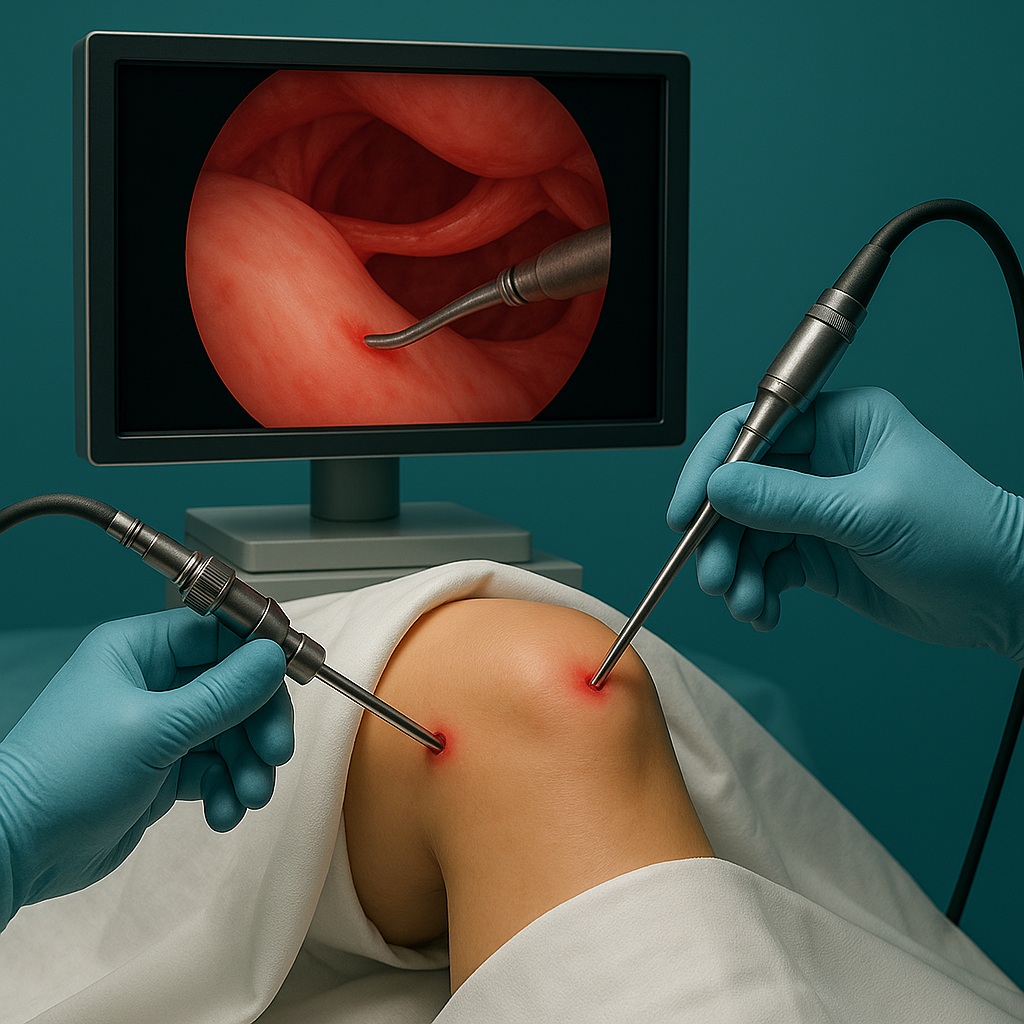Minimally Invasive Arthroscopic Surgery
For cases where surgical intervention is appropriate. Keyhole surgery excellence.
Advanced arthroscopic techniques through tiny incisions, preserving your natural anatomy while solving complex joint problems. Dr. Fawzy's decades of experience designed to optimize outcomes and support faster recovery.

What is Arthroscopic Surgery?
Understanding the advanced technique that allows many procedures to be performed as outpatient treatments
Arthroscopic surgery is often called "keyhole surgery" because it uses tiny incisions instead of large open cuts. A thin camera (arthroscope) and specialized instruments are inserted through 2-3 small holes, allowing your surgeon to see inside your joint and perform complex procedures with minimal tissue damage.
This advanced technique allows many procedures to be performed as outpatient treatments, supporting faster recovery and supporting return to activities.
The Difference:
Traditional open surgery requires cutting through muscles and tissues to reach the problem. Arthroscopy works around your natural anatomy, preserving healthy tissue and joint function.
Joints We Treat Arthroscopically
Comprehensive arthroscopic expertise across all major joints
Knee Arthroscopy
The most common arthroscopic procedure. Treats ACL tears, meniscus problems, cartilage damage, and removes loose bodies or bone spurs that cause pain and catching sensations.
Advanced techniques including ACL reconstruction, meniscus repair, and cartilage restoration through tiny keyhole incisions.
Shoulder Arthroscopy
Repairs rotator cuff tears, removes bone spurs causing impingement, fixes labral tears (SLAP lesions), and stabilizes dislocating shoulders without large surgical scars.
Complex rotator cuff repairs and shoulder stabilization procedures using minimally invasive techniques proven over decades.
Hip Arthroscopy
Treats hip impingement (FAI), labral tears, and cartilage problems that cause deep hip pain. Preserves your natural hip joint and prevents future arthritis.
Advanced hip preservation techniques including labral repair and bone reshaping through minimal incisions.
Ankle Arthroscopy
Both anterior (front) and posterior (back) ankle arthroscopy removes bone spurs, treats impingement, and repairs ligaments causing chronic ankle instability.
Specialized anterior and posterior ankle techniques that restore full range of motion and prevent re-injury.
Elbow Arthroscopy
Removes bone spurs, loose bodies, and inflamed tissue causing elbow pain. Treats tennis elbow, golfer's elbow, and throwing injuries in athletes.
Precise elbow arthroscopy for sports injuries and chronic pain conditions affecting grip strength and throwing ability.
Wrist Arthroscopy
Repairs TFCC tears (triangular fibrocartilage complex), removes impinging tissue, and treats wrist instability through tiny incisions that heal with minimal scarring.
Complex wrist repairs that maintain full wrist function and strength for athletes and active individuals.
Why Choose Arthroscopic Surgery?
Designed for optimal outcomes and faster recovery with minimal disruption to your life
Faster Recovery
Return to work in days instead of weeks. Resume sports and activities months faster than traditional open surgery. The preserved muscle and tissue heal quickly because they weren't cut during surgery.
Minimal Scarring
2-3 tiny incisions that fade to nearly invisible marks instead of large surgical scars. Most patients can't find their arthroscopy scars after one year.
Less Pain
Minimal tissue damage means less post-operative pain and reduced need for strong pain medications. Most patients manage comfort with over-the-counter medications.
Outpatient Procedure
Go home the same day instead of hospital stays. Sleep in your own bed and recover in familiar surroundings with family support.
Precise Treatment
The arthroscopic camera provides magnified, high-definition views inside your joint. This allows treatment of the exact problem area without affecting healthy tissue.
Reduced Complications
Lower infection risk, less bleeding, and minimal stiffness compared to open surgery. Your body's natural healing response works more effectively.
The Arthroscopic Advantage
Understanding why minimally invasive techniques deliver optimal outcomes
Traditional Surgery Problems
- Large incisions through healthy muscle
- Longer hospital stays and recovery
- Significant post-operative pain
- Higher infection and complication rates
- Extensive scarring and tissue damage
Arthroscopic Solutions
- Tiny incisions preserving healthy tissue
- Same-day outpatient procedures
- Minimal pain and faster healing
- Lower complication rates
- Nearly invisible scars
Real Difference:
A knee replacement requires a 6-8 inch incision and months of recovery. Knee arthroscopy uses 3 tiny holes and most patients walk normally within days.
Recovery Timeline
Structured rehabilitation designed for optimal healing and return to activity
Week 1-2
Initial Healing
- Small bandages over tiny incisions
- Gentle movement and basic activities
- Return to desk work for most procedures
- Pain well-controlled with simple medications
Week 2-6
Progressive Activity
- Physical therapy begins
- Gradual return to normal daily activities
- Driving when comfortable (usually 3-7 days)
- Light exercise and swimming
Week 6-12
Sport-Specific Training
- Advanced strengthening protocols
- Sport-specific movement patterns
- Agility and coordination training
- Preparation for competitive return
Month 3-4
Full Return
- Return to sports and activities
- Performance development
- Injury prevention education
- Long-term maintenance programs
Advanced Arthroscopic Surgery for Active Individuals
For cases where surgical intervention is appropriate, advanced arthroscopic surgery offers excellent outcomes with faster recovery. Get expert evaluation to determine if minimally invasive surgery is right for you.
 WhatsApp Us
WhatsApp Us